状 语 从 句 详 解
- 格式:ppt
- 大小:226.00 KB
- 文档页数:27
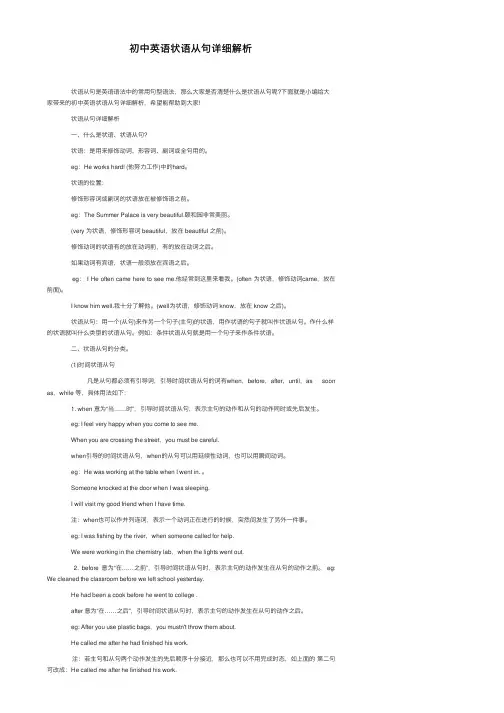
初中英语状语从句详细解析 状语从句是英语语法中的常⽤句型语法,那么⼤家是否清楚什么是状语从句呢?下⾯就是⼩编给⼤家带来的初中英语状语从句详细解析,希望能帮助到⼤家! 状语从句详细解析 ⼀、什么是状语、状语从句? 状语:是⽤来修饰动词、形容词、副词或全句⽤的。
eg:He works hard! (他努⼒⼯作)中的hard。
状语的位置: 修饰形容词或副词的状语放在被修饰语之前。
eg:The Summer Palace is very beautiful.颐和园⾮常美丽。
(very 为状语,修饰形容词 beautiful,放在 beautiful 之前)。
修饰动词的状语有的放在动词前,有的放在动词之后。
如果动词有宾语,状语⼀般须放在宾语之后。
eg: I He often came here to see me.他经常到这⾥来看我。
(often 为状语,修饰动词came,放在前⾯)。
I know him well.我⼗分了解他。
(well为状语,修饰动词 know,放在 know 之后)。
状语从句:⽤⼀个(从句)来作另⼀个句⼦(主句)的状语,⽤作状语的句⼦就叫作状语从句。
作什么样的状语就叫什么类型的状语从句。
例如:条件状语从句就是⽤⼀个句⼦来作条件状语。
⼆、状语从句的分类。
(1)时间状语从句 凡是从句都必须有引导词,引导时间状语从句的词有when,before,after,until,as soon as,while 等,具体⽤法如下: 1. when 意为“当……时”,引导时间状语从句,表⽰主句的动作和从句的动作同时或先后发⽣。
eg: I feel very happy when you come to see me. When you are crossing the street,you must be careful. when引导的时间状语从句,when的从句可以⽤延续性动词,也可以⽤瞬间动词。
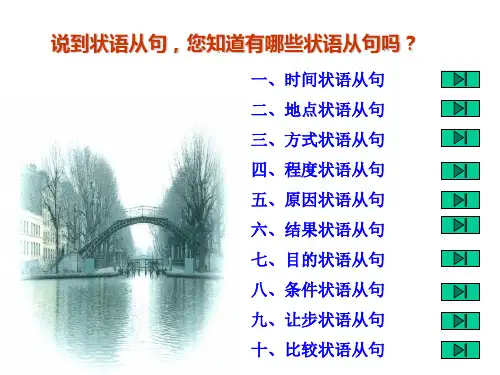
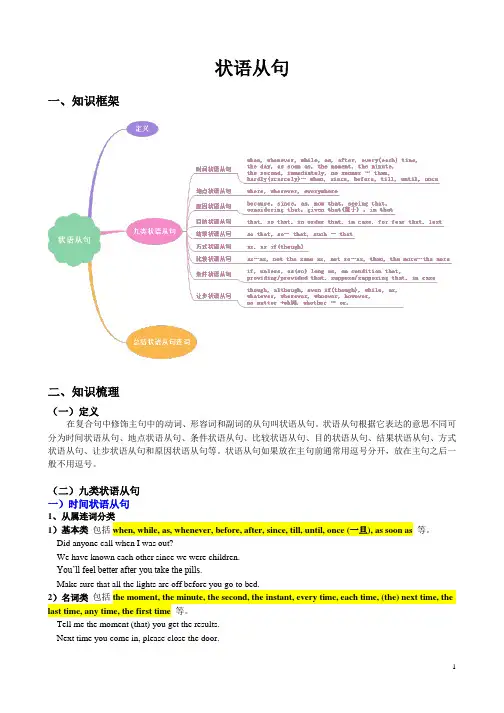
状语从句一、知识框架二、知识梳理(一)定义在复合句中修饰主句中的动词、形容词和副词的从句叫状语从句。
状语从句根据它表达的意思不同可分为时间状语从句、地点状语从句、条件状语从句、比较状语从句、目的状语从句、结果状语从句、方式状语从句、让步状语从句和原因状语从句等。
状语从句如果放在主句前通常用逗号分开,放在主句之后一般不用逗号。
(二)九类状语从句一)时间状语从句1、从属连词分类1)基本类包括when, while, as, whenever, before, after, since, till, until, once (一旦), as soon as等。
Did anyone call when I was out?We have known each other since we were children.You’ll feel better after you take the pills.Make sure that all the lights are off before you go to bed.2)名词类包括the moment, the minute, the second, the instant, every time, each time, (the) next time, the last time, any time, the first time等。
Tell me the moment (that) you get the results.Next time you come in, please close the door.He felt nervous each time she spoke to him.The last time we talked he said he needed another two days.3)副词类如immediately, directly, instantly, presently等。

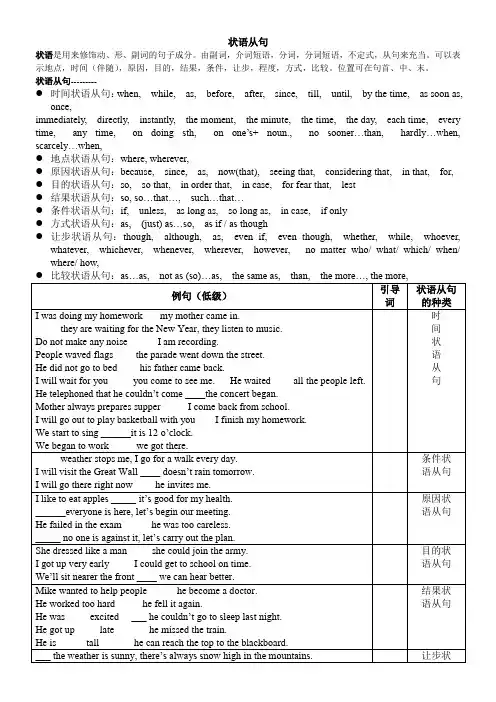
状语从句状语是用来修饰动、形、副词的句子成分。
由副词,介词短语,分词,分词短语,不定式,从句来充当。
可以表示地点,时间(伴随),原因,目的,结果,条件,让步,程度,方式,比较。
位置可在句首、中、末。
状语从句---------●时间状语从句:when, while, as, before, after, since, till, until, by the time, as soon as,once,immediately, directly, instantly, the moment, the minute, the time, the day, each time, every time, any time, on doing sth, on one’s+ noun., no sooner…than, hardly…when, scarcely…when,●地点状语从句:where, wherever,●原因状语从句:because, since, as, now(that), seeing that, considering that, in that, for, ●目的状语从句:so, so that, in order that, in case, for fear that, lest●结果状语从句:so, so…that…, such…that…●条件状语从句:if, unless, as long as, so long as, in case, if only●方式状语从句:as, (just) as…so, as if / as though●让步状语从句:though, although, as, even if, even though, whether, while, whoever,whatever, whichever, whenever, wherever, however, no matter who/ what/ which/ when/ where/ how,。
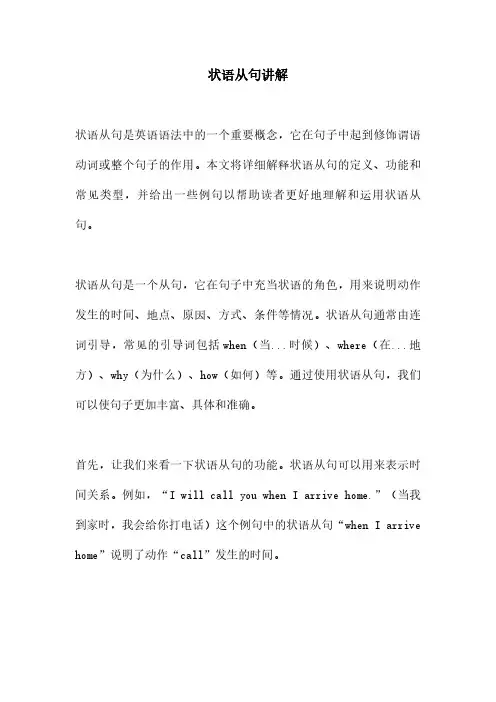
状语从句讲解状语从句是英语语法中的一个重要概念,它在句子中起到修饰谓语动词或整个句子的作用。
本文将详细解释状语从句的定义、功能和常见类型,并给出一些例句以帮助读者更好地理解和运用状语从句。
状语从句是一个从句,它在句子中充当状语的角色,用来说明动作发生的时间、地点、原因、方式、条件等情况。
状语从句通常由连词引导,常见的引导词包括when(当...时候)、where(在...地方)、why(为什么)、how(如何)等。
通过使用状语从句,我们可以使句子更加丰富、具体和准确。
首先,让我们来看一下状语从句的功能。
状语从句可以用来表示时间关系。
例如,“I will call you when I arrive home.”(当我到家时,我会给你打电话)这个例句中的状语从句“when I arrive home”说明了动作“call”发生的时间。
其次,状语从句可以表示地点关系。
例如,“She looked around to see where the noise was coming from.”(她四处看看,想知道声音是从哪里传来的)这个例句中的状语从句“where the noise was coming from”说明了动作“look around”的地点。
此外,状语从句还可以表示原因、条件和方式等关系。
例如,“He couldn't go to the party because he was sick.”(他因为生病所以不能去参加聚会)这个例句中的状语从句“because he was sick”表示了动作“couldn't go”的原因。
在使用状语从句时,需要注意一些语法规则。
首先,状语从句通常放在主句之前或之后,具体位置取决于需要强调的内容。
其次,状语从句的谓语动词通常使用一般现在时,而不受主句的时态影响。
例如,“I will call you when I arrive home.”(当我到家时,我会给你打电话)中的“arrive”使用的是一般现在时。
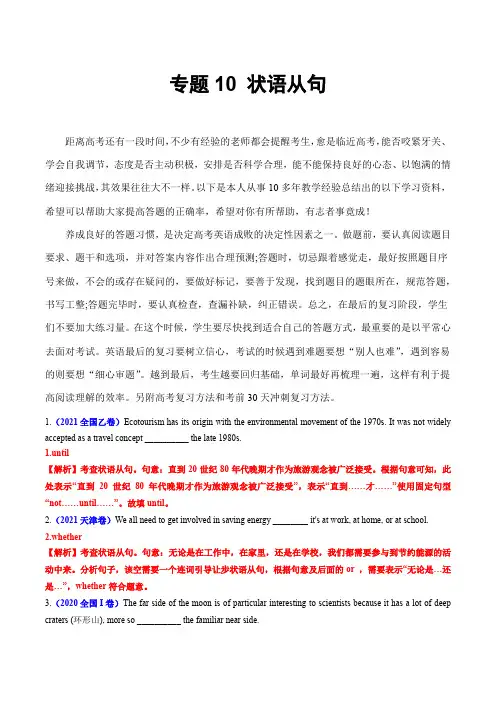
专题10 状语从句距离高考还有一段时间,不少有经验的老师都会提醒考生,愈是临近高考,能否咬紧牙关、学会自我调节,态度是否主动积极,安排是否科学合理,能不能保持良好的心态、以饱满的情绪迎接挑战,其效果往往大不一样。
以下是本人从事10多年教学经验总结出的以下学习资料,希望可以帮助大家提高答题的正确率,希望对你有所帮助,有志者事竟成!养成良好的答题习惯,是决定高考英语成败的决定性因素之一。
做题前,要认真阅读题目要求、题干和选项,并对答案内容作出合理预测;答题时,切忌跟着感觉走,最好按照题目序号来做,不会的或存在疑问的,要做好标记,要善于发现,找到题目的题眼所在,规范答题,书写工整;答题完毕时,要认真检查,查漏补缺,纠正错误。
总之,在最后的复习阶段,学生们不要加大练习量。
在这个时候,学生要尽快找到适合自己的答题方式,最重要的是以平常心去面对考试。
英语最后的复习要树立信心,考试的时候遇到难题要想“别人也难”,遇到容易的则要想“细心审题”。
越到最后,考生越要回归基础,单词最好再梳理一遍,这样有利于提高阅读理解的效率。
另附高考复习方法和考前30天冲刺复习方法。
1.(2021全国乙卷)Ecotourism has its origin with the environmental movement of the 1970s. It was not widely accepted as a travel concept __________ the late 1980s.1.until【解析】考查状语从句。
句意:直到20世纪80年代晚期才作为旅游观念被广泛接受。
根据句意可知,此处表示“直到20世纪80年代晚期才作为旅游观念被广泛接受”,表示“直到……才……”使用固定句型“not……until……”。
故填until。
2.(2021天津卷)We all need to get involved in saving energy ________ it's at work, at home, or at school.2.whether【解析】考查状语从句。
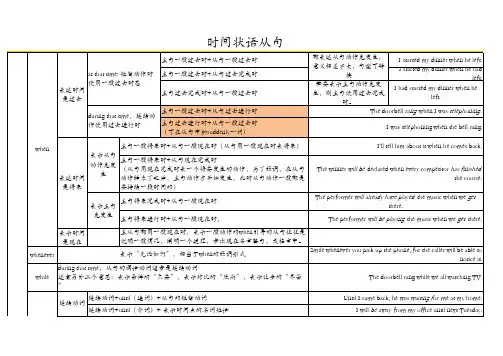
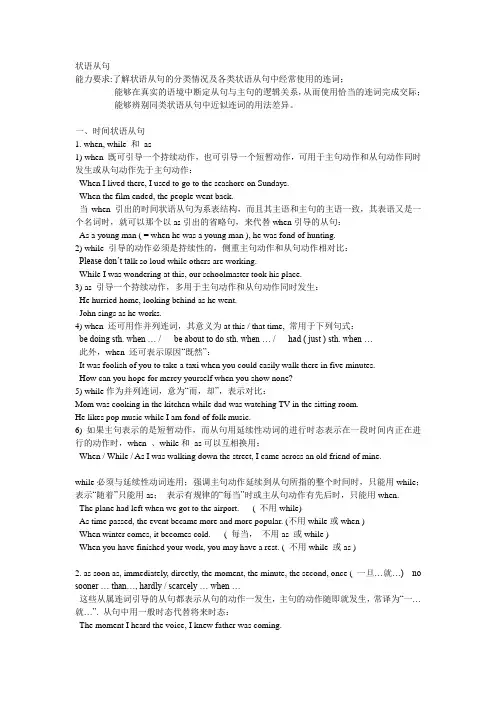
状语从句能力要求:了解状语从句的分类情况及各类状语从句中经常使用的连词;能够在真实的语境中断定从句与主句的逻辑关系,从而使用恰当的连词完成交际;能够辨别同类状语从句中近似连词的用法差异。
一、时间状语从句1. when, while 和as1) when 既可引导一个持续动作,也可引导一个短暂动作,可用于主句动作和从句动作同时发生或从句动作先于主句动作:When I lived there, I used to go to the seashore on Sundays.When the film ended, the people went back.当when 引出的时间状语从句为系表结构,而且其主语和主句的主语一致,其表语又是一个名词时,就可以那个以as引出的省略句,来代替when引导的从句:As a young man ( = when he was a young man ), he was fond of hunting.2) while 引导的动作必须是持续性的,侧重主句动作和从句动作相对比:Please don’t ta lk so loud while others are working.While I was wondering at this, our schoolmaster took his place.3) as 引导一个持续动作,多用于主句动作和从句动作同时发生:He hurried home, looking behind as he went.John sings as he works.4) when 还可用作并列连词,其意义为at this / that time, 常用于下列句式:be doing sth. when … / be about to do sth. when … / had ( just ) sth. when …此外,when 还可表示原因“既然”:It was foolish of you to take a taxi when you could easily walk there in five minutes.How can you hope for mercy yourself when you show none?5) while作为并列连词,意为“而,却”,表示对比:Mom was cooking in the kitchen while dad was watching TV in the sitting room.He likes pop music while I am fond of folk music.6) 如果主句表示的是短暂动作,而从句用延续性动词的进行时态表示在一段时间内正在进行的动作时,when 、while和as可以互相换用:When / While / As I was walking down the street, I came across an old friend of mine.while必须与延续性动词连用;强调主句动作延续到从句所指的整个时间时,只能用while;表示“随着”只能用as;表示有规律的“每当”时或主从句动作有先后时,只能用when.The plane had left when we got to the airport. ( 不用while)As time passed, the event became more and more popular. (不用while或when )When winter comes, it becomes cold. ( 每当,不用as 或while )When you have finished your work, you may have a rest. ( 不用while 或as )2. as soon as, immediately, directly, the moment, the minute, the second, once ( 一旦…就…) no sooner … than…, hardly / scarcely … when …这些从属连词引导的从句都表示从句的动作一发生,主句的动作随即就发生,常译为“一…就…”. 从句中用一般时态代替将来时态:The moment I heard the voice, I knew father was coming.The boy burst into tears immediately he saw his mother.Once you remember it, you will never forget it.No sooner had we arrived at the station than the train left.最后三个句式中,no sooner与hardly / scarcely 引导的主句谓语动词要用过去完成时,而than 与when的从句中要用一般过去时,此外,当把no sooner与hardly / scarcely提到句首时,应用倒装语序:I had hardly got home when it began to rain. = Hardly had I got home when it began to rain. On + v-ing ( hearing, seeing, returning等) 或n.( arrival, return等) 也等于as soon as.3. till, until 和not … until1) 肯定句:主句谓语动词必须是延续性动词,主句、从句都为肯定式,意为“某动作一直延续到某点时间才停止”:He remained there until / till she arrived.You may stay here until the rain stops.2) 否定句:主句谓语动词必须是非延续性动词,从句肯定式,意为“某动作知道某时间才开始”。
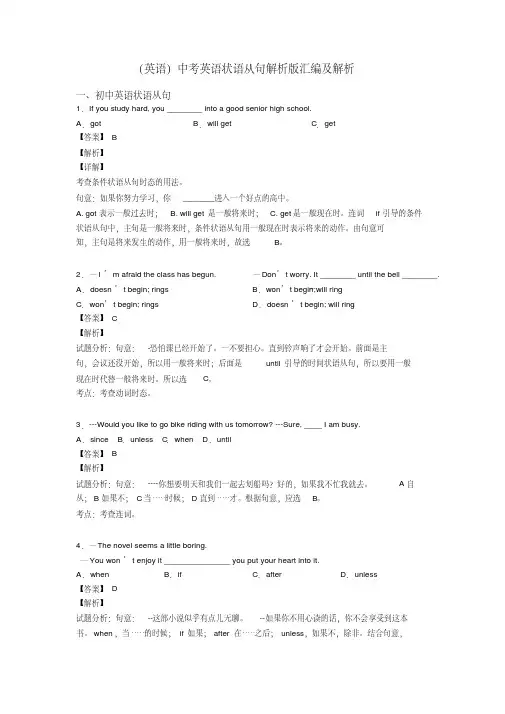
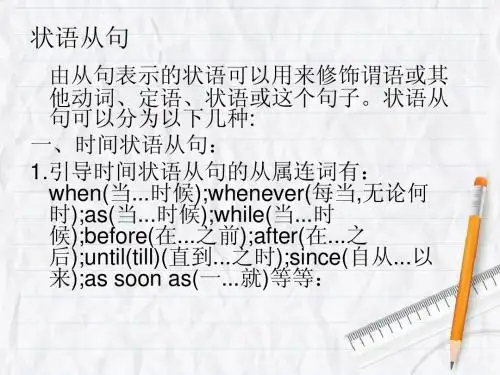
【英语】状语从句知识点梳理及经典练习(超详细)经典1一、初中英语状语从句1.--Peter, please send us postcards we’ll know where you have visited.--No problem.A.but B.or C.for D.so【答案】D【解析】句意:——彼得,请给我们及明星片,这样我们将会知道你参观过哪里。
——没问题。
but 但是,表示转折关系;or或者,表示选择;for为了,表示原因;so所以,表示结果。
结合句意,前半句让彼得给我们及明信片,后半句知道彼得到哪里参观了,后一句是前一句的结果,故用连词so。
故选D。
2.Tony has had to cook by himself ________ his mother went on business to Guangzhou. A.since B.after C.during D.when【答案】A【解析】【详解】句意:自从妈妈去广州出差以来,托尼不得不自己做饭。
A. since从……以来;B. after在……之后;C. during 在……期间;D. when当……时候。
since后跟时间状语从句时,表示的是到目前为止的时间段,从句时态为一般过去时,而主句的时态为现在完成时,故正确答案为A。
3.He has made great progress his mother is very pleased with him.A.so;that B.enough;to C.so;too D.such;that【答案】D【解析】【详解】句意:他已经取得了如此大的进步以至于他的妈妈对他非常满意。
从句意可知这里需要用到“如此….以至于”so+形容词/副词+that或such+名词+that,根据句子中的great progress意思是很大的进步,是名词短语,故用such…that, 故选D。
4.___________ she couldn’t see his face, she could tell by his voice that he was young. A.Unless B.If C.Because D.Though【答案】D【解析】【详解】句意:虽然她看不见他的脸,但是她能够通过声音分辨出他很年轻。
语法讲解一、定语从句:在复合句中,修饰某一名词或者代词的从句叫做定语从句。
如:The story (that) you read is interesting定语从句放在先行词的后面。
引导定语从句的词有关系代词that , which , who (宾格whom,所有格whose)和关系副词where, when, why。
关系代词或关系副词在定语从句中充当一个成分。
(一)、关系代词(人,物)1、This is the man (who) helped me . 主语,人2、The girl (whom) I met looks like Lily. 宾语,人3、A plane is a machine (that) can fly. 主语,宾格,人,物4、This is a book (which) you want. 主语,宾格,物5、The room (whose) window is red is mine. 主语,宾语,人,物(二)、关系副词(状语)1、It happened on the day (when)I was out. 时间2、I recently went to the town (where) I was born. 地点3、The reason (why) he didn't come was that he missed his train. 原因二、状语从句:1 时间状语从句:在一个句子中作时间状语的句子。
时间状语的连接词:when(当…时候) while(当…时候) as(当…时候) after(在…以后) before(在…以前) as soon as(一…就) since(自从…到现在) till /until(直到…才) by the time(到…为止)依旧是连接词后加陈述语序。
举例:when当…的时候(一般情况下主句是将来时的时候,从句要用一般现在时。
状语从句〔一〕状语从句概述〔二〕状语从句详解1. 时间状语从句2.地点状语从句3.条件状语从句4.原因状语从句5.目的状语从句6.结果状语从句7.让步状语从句8. 比拟状语从句9.方式状语从句练习一一. 单项填空1. _______ he’s old, he can still carry this heavy bag.A. ThoughB. SinceC. ForD. So2. ---Do you know if he _______ to play basketball with us"---I think he will e if he ______ free tomorrow.A. es; isB. es; will beC. will e; isD. will e; will be3. In the zoo if a child _____ into the water and can’t swim, the dolphins may e up ______ him.A. will fall; to helpB. falls; to helpC. will fall; helpD. falls; helping4. I don’t remember ________ he worked in that city when he was young.A. whatB. whichC. whereD. who5. We will stay at home if my aunt ________ to visit us tomorrow.A. esB. eC. will eD. is ing6. The police asked the children _______ cross the street ________ the traffic lights turned green.A. not; beforeB. don’t; whenC. not to; untilD. not; after7. I was late for class yesterday _______ there was something wrong with my bike.A. whenB. thatC. untilD. because8. I’ll go swimming with you if I ________ free tomor row.A. will beB. shall beC. amD. was9. In the e*am, the ________ you are, ______ the _______ mistakes you will make.A. careful; littleB. more careful; fewestC. more careful; fewerD. more careful; less10. You should finish your lessons _______ you go out to play.A. beforeB. afterC. whenD. while11. I hurried _____ I wouldn’t be late for class.A. sinceB. so thatC. as ifD. unless12. When you read the book, you’d better make a mark _______ you have any questions.A. whichB. thatC. whereD. though13. The teacher raised his voice _______ all the students could hear him.A. forB. so thatC. becauseD. in order14. He took off his coat _______ he felt hot.A. becauseB. asC. ifD. since15. It is ______ that we’d like to go out for a walk.A. a lovely dayB. too lovely a dayC. so lovely a dayD. such lovely a day16. Mary had ______ much work to do that she stayed at her office all day.A. suchB. soC. tooD. very17. _______ I felt very tired, I tried to finish the work.A. AlthoughB. BecauseC. AsD. As if18. ______ the day went on, the weather got worse.A. WithB. SinceC. WhileD. As19. ______ well you can drive, you must drive carefully.A. So long asB. In order thatC. No matter howD. The moment20. Write to me as soon as you ________ to Beijing.A. will getB. getC. gettingD. got二. 根据中文意思完成以下英语句子1. 不管他跟我开什么玩笑,我都不生气。
一、时间状语时间状语从句表时间,其关联词有as,after,before,once,since,till,until,while,when,whenever,as soon as,no sooner...t han,as long as,barely/hardly/scarcely...when,now (that)等As I was passing the gate, a dog flew out at me.当我经过门口时,一只狗向我扑来。
Fortunately the rain stopped before we started.幸亏在我们动身前雨停了。
Once inside her bedroom,she began to cry.一走进卧室,她就哭了。
Since I left college,I have not seen him.自从我离开大学以后,就没有见过他了。
He did not come till I left the hotel.直到我离开旅馆他才来。
Half the committee walked out on the chairman while he was still speaking.当主席仍在讲话时,委员会的半数成员便离席以示抗议。
When the teacher came in, Jed grabbed the novel on the desk.老师走进来时,杰德迅速把桌上的小说收起来。
Whenever I'm the only young person among all these older people,I feel out of it.每当我一个年轻人与这些老人在一起时总感到很不自在。
I'll never forget that as long as I am living.这事我至死也不会忘记。
The motor boat put on speed as soon as it left the pier.汽船一离开码头就加快了速度。